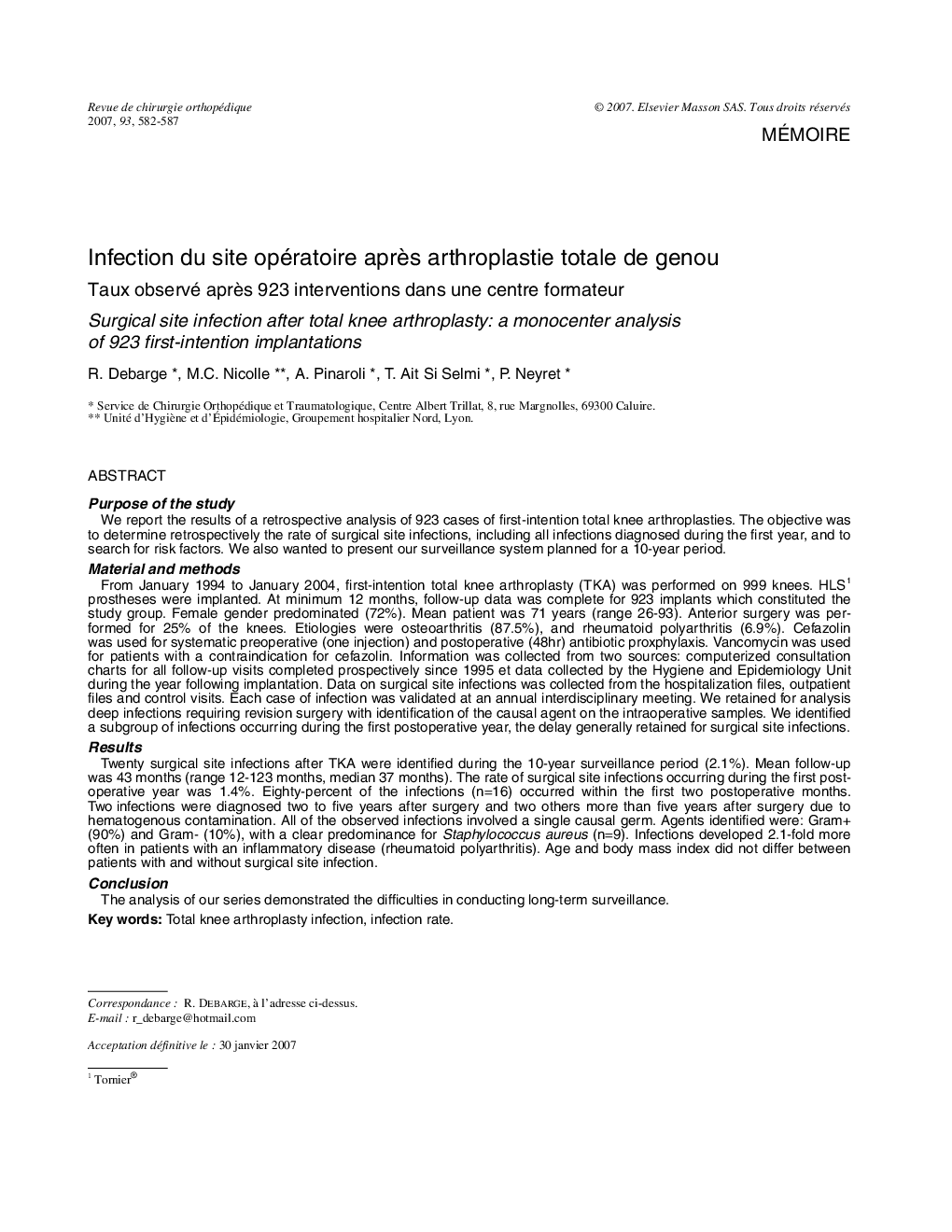| کد مقاله | کد نشریه | سال انتشار | مقاله انگلیسی | نسخه تمام متن |
|---|---|---|---|---|
| 4088576 | 1268109 | 2007 | 6 صفحه PDF | دانلود رایگان |

RésuméLe but de l’étude était d’évaluer de manière rétrospective le taux des infections sur site opératoire après une arthroplastie totale du genou de première intention en précisant le pourcentage d’infections survenues dans la première année, de chercher à mettre en évidence d’éventuels facteurs de risque infectieux et d’exposer notre système de surveillance sur une période de 10 ans. Entre janvier 1994 et janvier 2004, 999 patients ont subi une arthroplastie totale du genou cimentée HLS1 de première intention. Neuf cent vingt-trois dossiers ont pu être analysés avec un recul minimum de 12 mois. Nous disposions de deux sources d’information : le registre du service établi par les chirurgiens et les données de l’unité d’hygiène et d’épidémiologie. Nous avons relevé les caractéristiques cliniques et bactériologiques des patients infectés. Nous n’avons retenu que les infections profondes ayant nécessité une reprise avec mise en évidence d’un micro-organisme lors de prélèvements peropératoires. Le délai de surveillance des arthroplasties a été supérieur au délai d’un an retrouvé habituellement dans les définitions des infections sur site opératoire (CDC, CTIN). Le taux d’infection du site opératoire était de 2,1 % avec un recul moyen de 43 mois (12-123) et une médiane de suivi de 37 mois. Le taux d’infections survenues au cours de la première année était de 1,4 %. Nous avons observé plus d’infections chez les patients atteints de polyarthrite rhumatoïde et chez ceux déjà opérés du genou. Toutes les infections étaient à germe unique. Les germes retrouvés étaient des Gram positifs dans 90 % des cas et des Gram négatifs dans 10 %. Le Staphylococcus aureus était le germe le plus souvent retrouvé. Ce travail souligne l’intérêt d’une surveillance et les difficultés d’une estimation du nombre réel d’infection sur prothèse.
Purpose of the studyWe report the results of a retrospective analysis of 923 cases of first-intention total knee arthroplasties. The objective was to determine retrospectively the rate of surgical site infections, including all infections diagnosed during the first year, and to search for risk factors. We also wanted to present our surveillance system planned for a 10-year period.Material and methodsFrom January 1994 to January 2004, first-intention total knee arthroplasty (TKA) was performed on 999 knees. HLS1 prostheses were implanted. At minimum 12 months, follow-up data was complete for 923 implants which constituted the study group. Female gender predominated (72%). Mean patient was 71 years (range 26-93). Anterior surgery was performed for 25% of the knees. Etiologies were osteoarthritis (87.5%), and rheumatoid polyarthritis (6.9%). Cefazolin was used for systematic preoperative (one injection) and postoperative (48hr) antibiotic proxphylaxis. Vancomycin was used for patients with a contraindication for cefazolin. Information was collected from two sources: computerized consultation charts for all follow-up visits completed prospectively since 1995 et data collected by the Hygiene and Epidemiology Unit during the year following implantation. Data on surgical site infections was collected from the hospitalization files, outpatient files and control visits. Each case of infection was validated at an annual interdisciplinary meeting. We retained for analysis deep infections requiring revision surgery with identification of the causal agent on the intraoperative samples. We identified a subgroup of infections occurring during the first postoperative year, the delay generally retained for surgical site infections.ResultsTwenty surgical site infections after TKA were identified during the 10-year surveillance period (2.1%). Mean follow-up was 43 months (range 12-123 months, median 37 months). The rate of surgical site infections occurring during the first postoperative year was 1.4%. Eighty-percent of the infections (n=16) occurred within the first two postoperative months. Two infections were diagnosed two to five years after surgery and two others more than five years after surgery due to hematogenous contamination. All of the observed infections involved a single causal germ. Agents identified were: Gram+ (90%) and Gram- (10%), with a clear predominance for Staphylococcus aureus (n=9). Infections developed 2.1-fold more often in patients with an inflammatory disease (rheumatoid polyarthritis). Age and body mass index did not differ between patients with and without surgical site infection.ConclusionThe analysis of our series demonstrated the difficulties in conducting long-term surveillance.
Journal: Revue de Chirurgie Orthopédique et Réparatrice de l'Appareil Moteur - Volume 93, Issue 6, October 2007, Pages 582-587